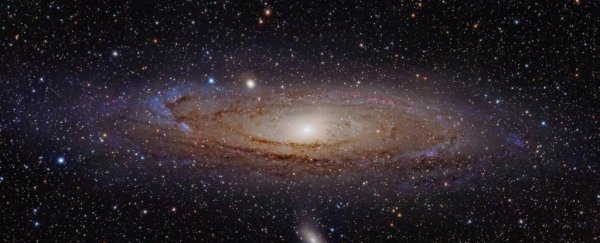A rare treasure that could shed light on the evolution of black holes has been discovered in the Milky Way's closest large galactic neighbor.
In a cluster of stars in the Andromeda galaxy, aka M31, astronomers studied changes in light to identify a black hole clocking in at almost 100,000 times the mass of the Sun. That places the beast squarely in the regime of "intermediate mass" – both elusive and highly sought by astronomers for the questions they can answer.
"We have very good detections of the biggest, stellar-mass black holes up to 100 times the size of our Sun, and supermassive black holes at the centers of galaxies that are millions of times the size of our sun, but there aren't any measurements of black holes between these," says astronomer and senior author of the study Anil Seth from the University of Utah.
"That's a large gap. This discovery fills the gap."
 Globular cluster B023-G78 in the Andromeda Galaxy. (Pechetti et al., The Astrophysical Journal, 2022)
Globular cluster B023-G78 in the Andromeda Galaxy. (Pechetti et al., The Astrophysical Journal, 2022)
Black holes are very tricky beasts. Unless they're actively accreting matter, a process that generates incredibly bright radiation, they give off no light we can detect. This makes finding them a matter of detective work, looking at what's happening in their surrounding space.
One such clue to the presence of a black hole is the orbit of objects around them.
Most of the black holes we've detected, using a variety of methods, fall into two mass ranges. There are the stellar-mass black holes, up to around 100 times the mass of the Sun; and supermassive black holes, which start at a low range of around a million times the mass of the Sun (and can get unbelievably chonky from there).
In the middle is a range classified as intermediate, and to say that detections of these black holes are rare is an understatement.
To date, the number of IMBH detections remains incredibly low. This is something of a vexation; without intermediate-mass black holes, scientists struggle to resolve how two wildly different mass regimes can coexist.
A solid population of black holes in the intermediate mass range could help us bridge the gap, proffering a mechanism whereby stellar-mass black holes can grow into behemoths.
This brings us to Andromeda; specifically, a globular cluster of stars within Andromeda called B023-G078.
B023-G078 is the most massive such star cluster in the galaxy, a roughly spherical, gravitationally bound cluster of stars clocking in at 6.2 million solar masses.
One way that these clusters can form, according to models, is when one galaxy subsumes another. This is a very common phenomenon; the Milky Way has done it several times, as has Andromeda. Globular clusters might be what's left of the galactic cores of smaller galaxies that get subsumed by larger ones, black holes and all.
This phenomenon is what the team – led by first author and astronomer Renuka Pechetti of Liverpool John Moores University in the UK – think is B023-G078's origin story.
They studied the metal content of the cluster, based on subtle signatures in the light it emits, and determined that it has an age of about 10.5 billion years, with a metallicity similar to those of other stripped galactic cores in the Milky Way.
They then studied the way the stars move around the center of the cluster to try to calculate the mass of the black hole that ought to be therein. This returned a result of around 91,000 solar masses, which constitutes around 1.5 percent of the mass of the cluster.
This suggests that B023-G078's parent galaxy was a dwarf galaxy, clocking in at around a billion solar masses. The mass of the Large Magellanic Cloud – a dwarf galaxy orbiting the Milky Way – has been calculated at 188 billion solar masses, and Andromeda is estimated to be up to around 1.5 trillion solar masses.
It's possible that something else accounts for the observations, but none of the alternatives explored by the team fit the data as well as an intermediate-mass black hole.
"We knew that there must be smaller black holes in lower mass stripped nuclei, but there's never been direct evidence," Pechetti says.
"I think this is a pretty clear case that we have finally found one of these objects."
The findings are reported in The Astrophysical Journal.
An earlier version of this article was published in November 2021.
